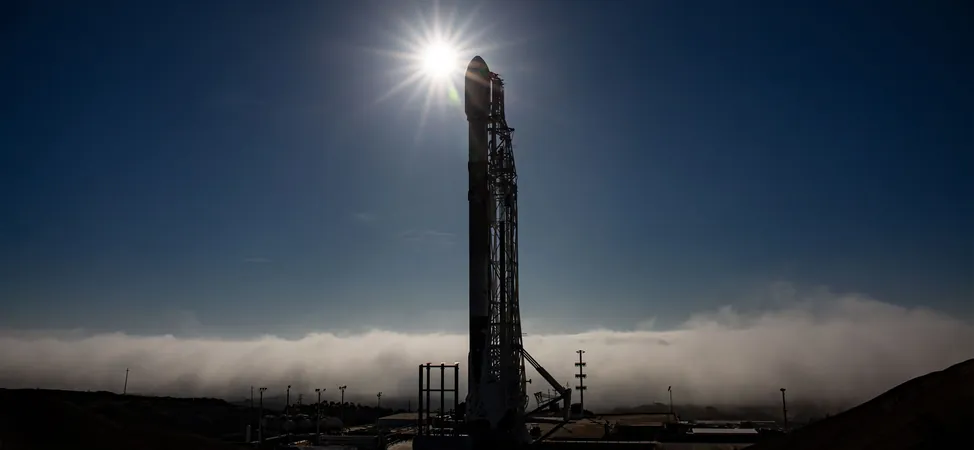
Stellar Launches: SpaceX Soars Again with Koreasat 6A and Starlink Missions, China Prepares for Tiangong Resupply
2024-11-11
Author: Yu
In an exciting week for global space exploration, SpaceX and China's space program are set to make significant strides with multiple launches. While SpaceX gears up for the sixth integrated test flight of its Starship, they recently celebrated the successful deployment of the Koreasat 6A communications satellite, alongside a series of Starlink missions aimed at achieving wider internet coverage.
SpaceX Hits New Heights with Koreasat 6A
On November 11, SpaceX launched the Koreasat 6A satellite aboard a Falcon 9 rocket from Launch Complex 39A at Kennedy Space Center, marking a milestone in satellite communication for South Korea. The Falcon 9 liftoff took place at 12:22 PM EST, utilizing the pad for the first time since NASA's Europa Clipper mission. The rocket made a triumphant return, landing safely at Landing Zone 1, achieving yet another successful recovery for SpaceX.
The Koreasat 6A, weighing in at approximately 3,500 kg, was designed with a 15-year operational lifespan and will occupy the 116-degree east orbital slot, replacing its predecessor, Koreasat 6. This new satellite is equipped with 20 transponders dedicated to fixed services and six for broadcasting, catering to South Korea's communication needs.
Starlink Drives Towards Dominance
Hot on the heels of the Koreasat launch, SpaceX executed its Starlink 6-69 mission later that same day, deploying an impressive 24 Starlink v2 Mini satellites into low-Earth orbit. This was the 108th Falcon 9 mission in 2024 and the second launch from Florida on that day. As the satellite network expands, the total number of Starlink satellites deployed now reaches an astounding 7,256 worldwide.
Not stopping there, SpaceX is also preparing for upcoming Starlink missions, including Starlink 9-11 and Starlink 6-68, showcasing its commitment to creating a robust satellite internet system that continues to grow at a remarkable pace.
China’s Ambitious Plans for Tiangong
Across the globe, China is preparing for an intriguing set of launches, including an unknown payload from the Taiyuan Satellite Launch Center. This anticipated launch is expected to take place on November 13 and could lead to new developments in their satellite capabilities.
The week will also see the liftoff of the Tianzhou 8 cargo spacecraft, set for November 15, aimed at resupplying the Tiangong space station. This pivotal mission utilizes the Chang Zheng 7 rocket and represents a vital step in sustaining China's presence in space. The Tianzhou 8 will transport essential supplies and equipment to the Shenzhou-19 crew currently aboard Tiangong, further emphasizing China's commitment to expanding its space exploration and operations.
Upcoming Launches and Records in Sight
Over the next few days, more Falcon 9 launches are scheduled, including the Optus-X communications satellite mission on November 17, which promises to enhance satellite communication capabilities and extend the life of existing satellites.
With each successful launch, SpaceX is on track to break records for the number of missions flown in a single year, further solidifying its position as a leader in the aerospace industry. The competition in the space race has never been more intense, and both SpaceX and China's advancements signal an exhilarating era for space exploration. Stay tuned for more updates as these groundbreaking missions unfold!



 Brasil (PT)
Brasil (PT)
 Canada (EN)
Canada (EN)
 Chile (ES)
Chile (ES)
 España (ES)
España (ES)
 France (FR)
France (FR)
 Hong Kong (EN)
Hong Kong (EN)
 Italia (IT)
Italia (IT)
 日本 (JA)
日本 (JA)
 Magyarország (HU)
Magyarország (HU)
 Norge (NO)
Norge (NO)
 Polska (PL)
Polska (PL)
 Schweiz (DE)
Schweiz (DE)
 Singapore (EN)
Singapore (EN)
 Sverige (SV)
Sverige (SV)
 Suomi (FI)
Suomi (FI)
 Türkiye (TR)
Türkiye (TR)